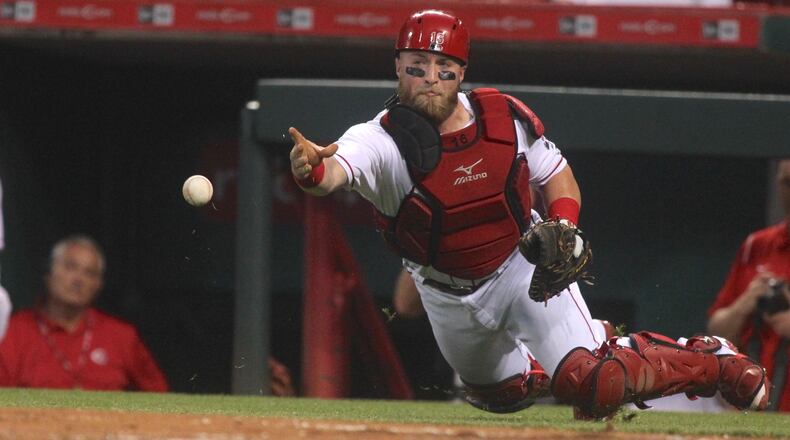“I started last year, so that was a more anxious time,” he said Friday before the Reds began the season against the Washington Nationals. “This year I’m just ready to go. The way I prepare hasn’t changed at all, so I think that lends me to be able to feel comfortable and in control, not necessarily feel jittery or anxious or anything like that.”
»RELATED: 7 storylines to watch for 2018 season
»HAL MCCOY: Can Reds avoid another last-place finish?
»RELATED: Reds four-man OF rotation could bruise some egos
It’s easier to be comfortable after signing a four-year, $23 million contract, but the Brownsburg, Ind., native insisted that wasn’t a factor, either.
“I’ve always approached the offseason to be the starting catcher,” Barnhart said. ”Whether that materialized or not was based on circumstances, but it’s things I haven’t been able to control.”
That includes being drafted two years after the Reds spent a first-round pick on fellow catcher Devin Mesoraco, but the 2009 10th-round selection was ready when multiple injuries felled Mesoraco over the past three seasons.
Barnhart hit .270 with 44 RBIs last season while playing a career-high 121 games to earn that new deal.
More important is how he handled a young pitching staff, and he enters 2018 optimistic things should go smoother on that end.
Already having caught all of the Reds starters in regular season games prior to this season helps him know how to guide them through a game rather than having to learn on the fly, as he frequently did last year.
“Having a relationship that didn’t have to be built in spring training with most guys is nice,” he said. “It allows us to be more comfortable in knowing what pitches to call at what time and things like that.”
Those prior relationships might be even more crucial this year because in-game chats aren’t going to be as frequent.
Beginning this season, teams are only allowed six mound visits per nine innings (with some exceptions).
That is one of the initiatives passed with the goal of speeding up the game, a movement Barnhart said he understands but doesn’t necessarily like.
“Where I start to have a problem with the rules and stuff that they’re putting in is when they’re starting to put things in place that affect the integrity of the game,” he said. “It can affect the outcome of the game. We go out there and talk to pitchers to make sure we’re on the same page as far as what pitches need to be thrown, also with what signs need to be put down.
“So if I have a guy who comes in in the eighth inning and I’ve already been out there five times we can’t get on the same page and he’s crossing me up and guys are moving up bases, that can genuinely affect the outcome of the game. As we get into that territory with new rules, with different rules, that’s where I start to have a problem with it and I don’t necessarily like it very much.”
About the Author

